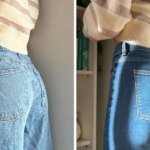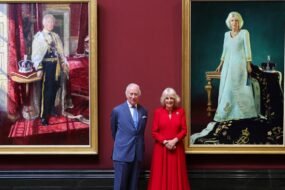
Unlock the Editor’s Digest for free
Roula Khalaf, Editor of the FT, selects her favourite stories in this weekly newsletter.
“I was walking up the King’s Road in London around six o’clock in the morning on a summer’s day, and the royal horses were being exercised,” says Cassandra Ellis, founder of paint brand Atelier Ellis, of the inspiration for one of the brand’s popular colours. “It’s literally the colour of the rump.”
All the Queen’s Horses is a brown so deep and dark that it’s almost black; it evokes leaf mulch and winter walks, coffee grinds and, well, horse behinds. “I think that’s the point, actually,” Ellis adds. “It’s extremely natural. And all our browns are very natural — no hard lines, no crispness, they just sort of disappear behind you.”
Ellis has been creating browns for a while; the company was set up in 2018 and had six among its initial 18 colours, including Warm Mud Brown, Bird’s Nest and its bestseller Fallen Plum (“the ripe brown of old plums, when you see them on the ground,” says Ellis, who has the shade in her library). It doesn’t surprise her that browns are enjoying a resurgence. But not, necessarily, the soft and saccharine Mocha Mousse, named by Pantone as the colour of 2025. It’s sludgy and swampy hues that are in demand: think stagnant, slimy ponds and muddy boots.


Paint colours such as Farrow & Ball’s Bancha green have racked up 20,000 hashtags on Instagram, used on front doors, in downstairs loos and living rooms. In California, interior designers Studio Muka plastered an entire 1950s cabin in a muddy green to satisfy its “tech power couple” owners’ dreams of “dwelling in the mountains, close to nature”.
We are, perhaps, living in an era so high octane that even the meditative powers of beige minimalism can’t soothe us. We’ve had enough of clean and fresh: mucky and muddy is what we’re rolling in.
“We’re living in a period that is more chaotic than it’s been since the second world war,” Ellis says. “And that’s before you add in technology. We just want to be rooted.” She also references the bright young things era that played out in the postwar landscape of the roaring twenties, when vibrant colours formed a manic backdrop to the hedonism. We’ve seen this replicated in the move towards maximalism in recent years, she argues — but it’s time for something different. “Brighter, brighter, brighter; clash, clash, clash. I think we’ve moved through that period now.”


Faye Toogood, artist and founder of Toogood design studio, also cites technological overload and environmental concerns as the reason behind our switch to sludge. “Artificial or natural intelligence? I know what we need more of right now,” she says. “A connection to nature feels like something we are craving more than ever because we know the link between our environment and our wellbeing and our overall health is critical.”
Toogood describes the landscape as a “constant and enduring” influence in her work; Gummy, the studio’s new upholstery collection, is made in a series of ochres, browns and greens in natural fibres. She has also used the colour palette at home: Farrow & Ball’s Drab and Broccoli Brown are both dun, rodentian colours featuring in rooms including the snug. She recently collaborated with the heritage paint brand on the mustard-tinged colour Earth.

Designer Hollie Bowden’s Instagram feed is a pleasing display of muted tones; among them a painting of an almost-caramel brown puffa jacket by artist Poppy Jones and the subterranean-looking green interior of the Brussels restaurant Les Brigittines. For her, heavy greens and browns are a neutral, and best deployed on the hard finishes of a home — the flooring, the woodwork — to create a background for less permanent, possibly brighter colours. She recently painted all of a home’s floorboards a dark green, before topping with a leopard-print carpet. “It lent a dramatic feeling to the house, but it also felt like a neutral.”
Bowden says the colours work in a country house in Gloucestershire or a pied à terre in Ibiza. “It’s a palette that makes me feel quite calm but it’s not boring. You can play around with it.” For those wanting to nudge to the sludge, she recommends looking to the tones of an Aubusson Verdure tapestry and using them on the floor or upholstery, while keeping walls white.


The designer used Bancha in her living room and another murky green in her studio: “It’s literally all greens and browns and sludges and a little lime.”
Murky greens are the designer’s choice it seems: almost everyone I speak to has painted browns and muddy greens in their own home. Ellis’s bedroom is in Tea and Toast.
Nature-driven tones may feel more comforting and necessary in the current climate. But, ultimately, brown is very pragmatic. “I think it’s a really, really easy colour to live with,” says Ellis, “It’s very forgiving.”
Find out about our latest stories first — follow @ft_houseandhome on Instagram










